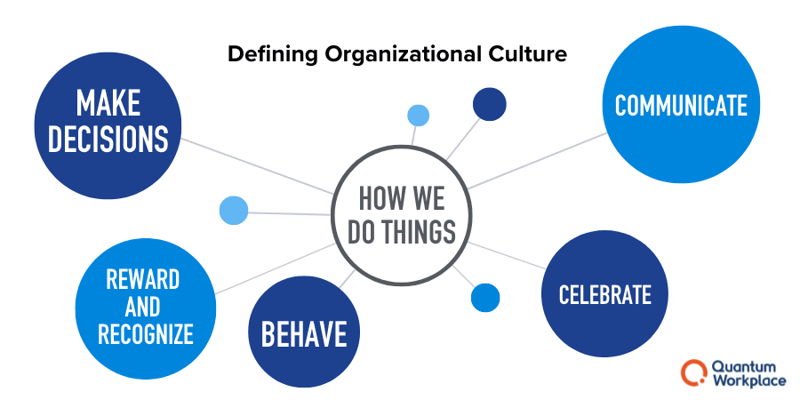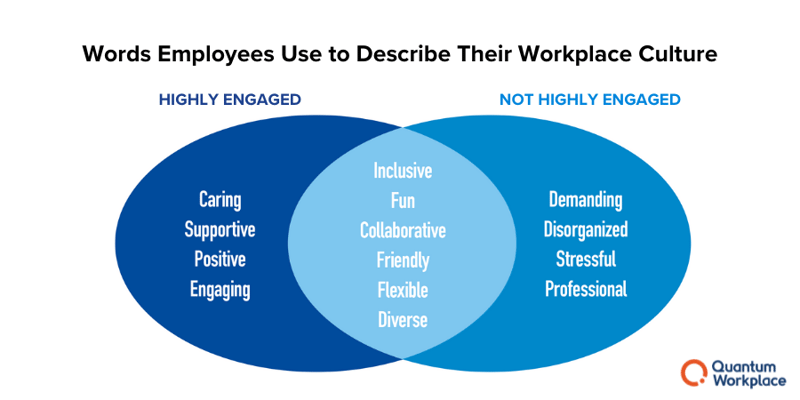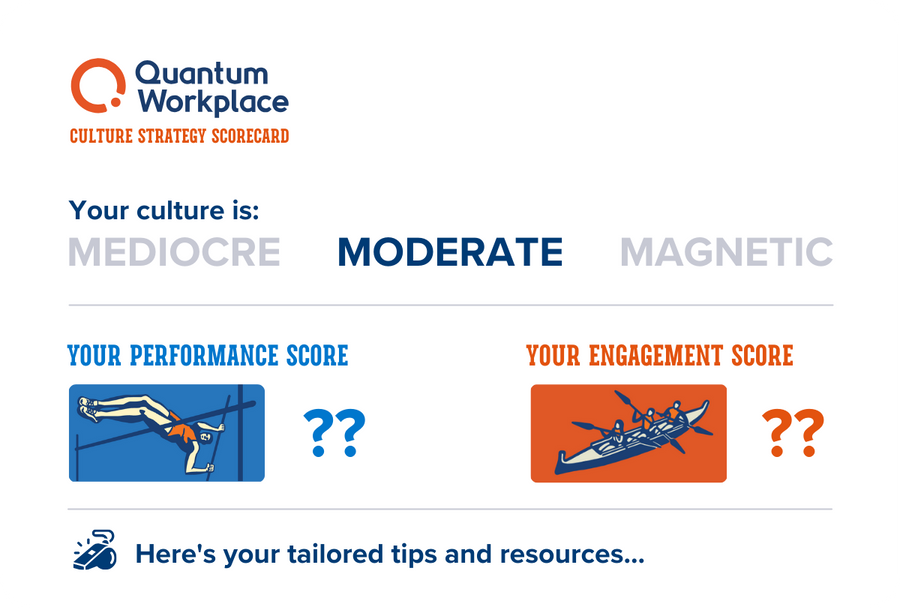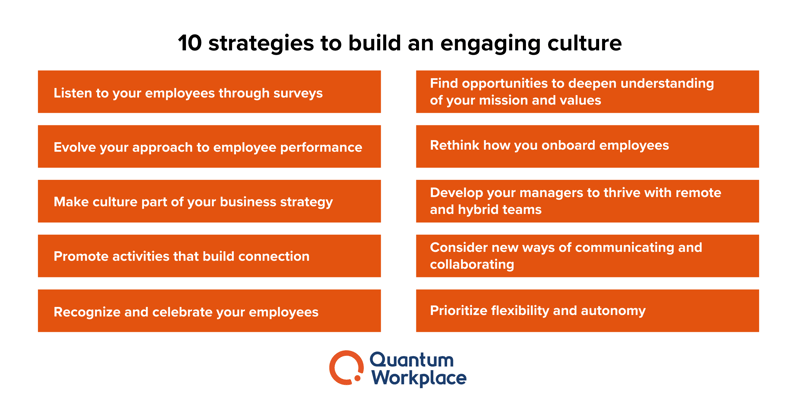What is Organizational Culture? (and How to Build a Strong One)
Culture is at the heart of every business and organization. But it’s more than just feel-good HR policies or foosball Fridays. Your organizational culture encompasses many facets of your organization—and ultimately, your bottom line.
So what is organizational culture? And how can you harness company culture to engage employees, improve performance, and make your company a great place to work? Culture is a fuzzy concept. It’s important to business success, but you can’t improve it if you can’t define it.
In this article, we’ll answer what organizational culture is, why it matters, and how you can build a strong and engaging culture. You’ll discover:
- What is organizational culture?
- Why is organizational culture important?
- How organizational culture has changed
- What does a good workplace culture look like?
- Examples of good company cultures
- Tips for shaping your organizational culture
- Finding the right tools to improve your culture
- Company culture FAQs
What is organizational culture?

Organizational culture is the way that organizations get things done. It’s how we make decisions, how we communicate, and how we celebrate employees. It’s the daily actions, attitudes, and behaviors that individually and collectively make up our organization.
Confusion often occurs in how employees experience this culture. You’ll find dozens of definitions of what workplace culture is and isn’t. Most of them will leave you with more questions than answers. And only a few definitions give you something that’s actually measurable.
Quantum Workplace research shows that company culture is felt most strongly, by employees through:
- Company mission and values
- Employee recognition and celebrations
- The organization’s approach to employee performance (50%)
Where do employees experience workplace culture the least?
- Rituals and norms
- Onboarding and training
- Physical workspace

This research indicates that we need to evolve our definition of organizational culture. The gut instinct might be that employees must be in the office to experience their workplace culture. But Quantum Workplace research emphasizes this is not the case.
It’s also important to note that culture isn’t a separate initiative to engagement and performance. It’s connected to the engagement and performance strategies you’re already doing. It’s in the fabric of what makes your organization unique. And it’s culture that will attract top talent, retain high-performing employees, and empower everyone to do their best work.
Why is organizational culture important?
You can’t get by with a mediocre culture. Culture should be prioritized as a competitive advantage. Your company culture impacts everything within your organization, every day. It can help or hinder you, depending on how intentional you are with it. An engaging organizational culture helps you:
- Attract high quality talent
- Boost employee engagement
- Increase employee retention
- Strengthen employee performance
- Adapt to change
- Accelerate business outcomes
Culture is how organizations compete for top talent and retain high-performing employees. Employees want more than just a paycheck. In fact, Glassdoor found that employees feel culture is more important than salary when it comes to employee satisfaction with their jobs. And when employees say you have a toxic workplace culture, it leads to negative behaviors and works against you in meeting organizational goals.
To attract top candidates and keep them, new hires need to be immersed in a positive company culture that connects back to core values. This helps employees connect the dots from their role to the overall business from day one.
Employees who say their culture is positive are 3.8x more likely to be engaged.
Company culture and employee engagement are inextricably linked. If you want to improve employee engagement, take a look at your culture. An engaging culture connects, equips, and empowers employees to do their best work.

Disengaged employees are 2.6x more likely to leave their company for a better culture.
Company culture and engagement are sticky factors that make employees want to stay. A Glassdoor survey says 7 in 10 employees would look for a job elsewhere if their workplace culture were to weaken. Culture is a critical retention strategy.
70% of high-performing organizations agree or strongly agree that culture is what drives their success on organizational and business outcomes.
There’s a reason company culture has become a top priority for leaders—especially leaders at high-performing organizations. They understand the connection between culture and success.

How organizational culture has changed
Workplace culture has historically been defined as organizational norms, rituals, and values. But how employees perceive company culture has changed.
1 in 3 employees has neutral or negative perceptions of their organization’s culture.
Company culture has changed over the last several years, especially as more organizations have adapted to remote and hybrid work. However, about a third of employees have poor perceptions of their workplace culture. This is a tough number to swallow considering the connection between culture, employee engagement, and employee retention.
50% of employees experience culture most strongly through their organization’s approach to employee performance.
In today’s employee-driven work environment, the way you manage performance has a strong impact on engagement and culture. Building a high performance culture is key.
Our workplace culture research shows that how managers create alignment, communicate, recognize, and give feedback all shape how employees experience your culture.
Only 28% of employees experience culture most strongly through the physical workspace.
Many leaders have expressed thoughts about the importance of the physical workspace on culture. But our research shows it’s least important to how employees experience culture. Today, more leaders are trying to bring people back to the office in an effort to improve organizational culture and connection. Since physical workspace is low on the list of influential factors, it’s not likely to make a strong impact or workplace culture.
Remote and hybrid employees are more favorable toward workplace culture.
Remote and hybrid work environments have increased over the last several years—and this shift has impacted employee perceptions of culture. 70% of remote and hybrid workers believe their company has a strong and positive culture, compared to 65% and 58% of on-site employees, respectively.
What does a successful workplace culture look like?
A strong workplace culture is aimed at engaging employees. As you work to shape your workplace culture, you want to make sure that you’re aiming your culture efforts at engagement.
What words do employees use to describe your company’s culture? Are the words associated with engagement? Engaged employees tend to describe their company cultures as inclusive, caring, supportive, fun, and collaborative. However, disengaged employees describe their organizational culture as demanding, disorganized, stressful, or professional.
As a whole, Quantum Workplace research shows that the top 10 words to describe a great workplace culture are:
- Flexible
- Inclusive
- Supportive
- Caring
- Collaborative
- Fun
- Engaging
- Innovative
- Diverse
- Positive

Remember that flexibility doesn’t always mean remote or hybrid work. Not every organization has those abilities. Flexibility can also mean the flexibility of when, how, or who employees work with.
Examples of good company cultures
Having a culture where employees want to be creates a magnetic effect. Top talent wants to join your organization. And employees want to stay and grow with you. How do you get there? Follow these three organizations and what they did to create a magnetic culture.
Seacoast Bank
Seacoast Bank wanted to create a culture that listens to and acts on insights to make employee experiences better. To do that, they leverage every person at the organization to shape workplace culture, not just leaders or HR. Each person shares in the responsibility of building the Seacoast Bank culture. Their hard work has increased their survey participation rate to 95% and has empowered managers to take action with their teams.
Learn more about what Seacoast Bank did to create a culture of employee success >>>
Bethpage Federal Credit Union
Bethpage Federal Credit Union wanted to expand nationally. This meant that they needed to create a united culture across multiple locations. So, they aimed to create a culture of thriving employees with a people-centric approach. Bethpage FCU benchmarked their engagement against other organizations, giving context to their own survey results. Then, they took action in focused areas. Over two years, employee perceptions of compensation fairness increased by 28%. The likelihood employees would recommend Bethpage FCU as a great place to work increased by 6%.
Learn more about how Bethpage Federal Credit Union shaped their company culture >>>
Grant Thornton
Grant Thornton challenged itself to become an employer of choice. They started their journey by what characteristics defined an employer of choice. Secondly, they implemented a robust employee feedback system. This gave them the information they needed to make meaningful changes to the employee experience. Grant Thornton used Quantum Workplace surveys and action planning tools to improve engagement, reducing turnover rates and enhancing their employer brand in the accounting industry.
Learn more about how Grant Thornton focused their culture on engaging employees >>>
Tips for developing a strong organizational culture
Rome wasn’t built in a day, and neither is your culture. A positive, culture-centric organization takes time to develop. To cultivate the kind of culture that inspires action, engages employees, and drives performance, you need to approach it thoughtfully and intentionally.
An article by the Harvard Business Review describes culture as dynamic—shifting incrementally and constantly in response to change. This requires a flywheel approach to collecting feedback, analyzing it, and acting on your culture.
What are the three biggest things you can do to shape organizational culture?

Ask: Gather employee feedback on culture.
You can’t rely on your gut to understand your culture. You need to ask employees about their experiences at work—they’ll tell you what they think and what they need from you. Collecting their honest feedback will help you understand what’s working and what’s not.
To develop an employee listening strategy that helps you measure and improve your culture, you should gather feedback at many milestones in the employee journey.
Don’t simply rely on your annual employee engagement survey. Supplement your listening with regular pulse surveys and employee lifecycle surveys to capture feedback at key moments like onboarding and exits.
Not sure what to ask? Here are some recommendations for employee survey questions about culture:
- The work I do contributes to fulfilling our organization’s mission.
- I see behaviors displayed across our organization that are consistent with our company’s core values.
- I have a good understanding of our organization’s mission, values, and goals.
- Our organization constantly looks for ways to improve products and services.
- The pace of work at our organization enables employees to do a good job.
- Our culture supports employees’ health and wellbeing.
Aha: Analyze your culture regularly.
Once you’ve got some data from your employee feedback, dig into it. Don’t analyze the feedback in a silo—connect it to other data and metrics like turnover and performance conversations. The goal is to paint a picture of what’s happening across the organization.
Figure out what an engaging culture should look like and plan goals and initiatives to get there.
Act: Develop a culture action plan.
Show employees you are committed to improving your culture by making meaningful changes that better the employee experience and help everyone reach their goals. When your employees are successful, you will be successful too.
A healthy culture drives employee engagement first and foremost. When you evaluate “how work gets done” at your organization, try to understand how each aspect could impact employee engagement. You want to ensure employees feel connected to their work, team, and organization through your culture strategies.
Everyone is responsible for organizational culture
It takes every person inside your organization to build an engaging and successful culture.
But employees say leaders and managers are primarily responsible for creating and shaping culture. Culture starts at the top. Make sure the leadership team is bought in to culture initiatives. Leaders should clearly define culture, communicate about it regularly, set a good example, and tie business outcomes to company values. This will empower all employees to develop, practice, and evolve cultural norms.
As an HR leader, your role in company culture is to fully understand the employee experience. That will help you facilitate and support ongoing coaching around culture efforts.
You’ll also need to empower managers in your culture initiatives. They’re crucial to nurturing relationships and aligning with leadership on culture. Through 1-on-1s, managers also connect employee growth and development with career aspirations.
Even though employees feel culture is a leadership initiative, they still play a roll. They provide feedback, support other team members, and aim to grow with the organization.
Be intentional with your company culture
If you’re not shaping your organizational culture, something or someone is. The best way to build a positive company culture is aiming your efforts at engagement. Employee engagement is how connected employees are to their work, team, and workplace. When your culture is working for you, it creates engaged employees.
How do you become intentional with organizational culture?
- Look at your performance management approach. Employees say this is one of the ways they feel workplace culture the strongest. Focus on your employee listening strategy, goal alignment, and how you create a continuous performance management system.
- Improve trust between employees and leaders. Relationships are built on trust. Create a culture of trust by listening to your employees. A positive work environment is built on transparency and open communication. Taking action on employee feedback also builds trust.
- Emphasize recognition. Employees want to feel valued. When they feel valued for their contributions, it reinforces the organization’s values and behaviors you want to see. Give recognition that helps connect efforts with organizational goals. And make sure it is human and authentic.
What about shaping culture in a remote/hybrid work environment?
Culture cannot and will not look the same as it once did. Forward-thinking, adaptable leaders need to shape their culture strategies with remote and hybrid employees in mind. Just because your employees are remote or hybrid, doesn’t mean you need to be worried about employees feeling organizational culture. These 10 strategies, backed by our research, will help you build an engaging culture for all employees.
- Listen to your employees through surveys
- Evolve your approach to employee performance
- Make culture part of your business strategy
- Promote activities that build connection
- Recognize and celebrate your employees
- Find opportunities to deepen understanding of your company’s mission and values
- Rethink how you onboard employees
- Develop your managers to thrive with remote and hybrid teams
- Consider new ways of communicating and collaborating
- Prioritize flexibility and autonomy
Find the right tools to help you improve your culture.
A robust employee engagement platform will outline the big picture behind your culture and help you understand where to focus and when. With the right tools, you can uncover deep insights, measure employee perceptions, and create a thriving culture. Here are the top benefits of a robust culture platform:
- Understand employee perceptions of culture with employee surveys
- Explore culture metrics and trends
- Recognize employee success
- Create conversations around culture
- Align employees and teams by elevating what matters
Understanding your culture is critical for creating a culture where employees want to be. You need a platform that can help not only measure culture, but take action to improve it. What should you look for?

|
Employee surveys – easily gather feedback from employeesCapturing the employee voice is important. But you also need a trusted strategy and efficient tools. Your survey tool should help you maximize employee participation, give you an accurate baseline, and move the needle on employee engagement. |

|
Action planning – take action on survey insights effectively and efficientlyEmployee surveys don’t create engaged employees. You need to streamline how you share and act on survey results. The right action planning solution should be a simple to use, expert-informed, AI-driven solution so you can take impactful action and boost engagement quickly. |
|

|
Recognition – celebrate employee work in connection with mission, values, and goalsRecognition is a top driver of engagement and retention. Your recognition tool should make every employee feel valued for their contributions. It should be fun and easy for everyone to spotlight great work and share success across the organization. |
|
Goals – connect the dots between employee work and business outcomesClear, aligned goals help employees understand how their work contributes to organizational success. Your goal management software should help teams set and track goals, while providing visibility so everyone can focus on the most important objectives. |
Ready to see how to improve your culture? Take our quick “culture fitness test” to uncover where you have muscle and where you might need a little extra conditioning. Our expert coaches will provide customized, actionable advice to boost your culture’s strength and endurance. Don't settle for mediocrity. Get your scorecard and see how you stack up!!
How do employees experience company culture?
Research shows that organizational culture is felt most strongly by employees through the company mission and values, employee recognition and celebrations, and the organization’s approach to employee performance. They’re least likely to feel workplace culture through rituals and norms, onboarding and training, and the physical workspace.
What role do I play in shaping organizational culture?
Everyone plays a role in workplace culture. Leaders define company culture and model it. HR helps understand culture through employee listening. Managers build connection and trust with their teams. And employees provide honest and thoughtful feedback.
How do I measure workplace culture?
You have to fully understand your culture so you can shape it. Start with employee surveys to gather feedback about your culture and how employees experience it. You can also take our 6-minute Culture Scorecard to better understand your culture and get personalized tips for how to take it from mediocre to magnetic.









